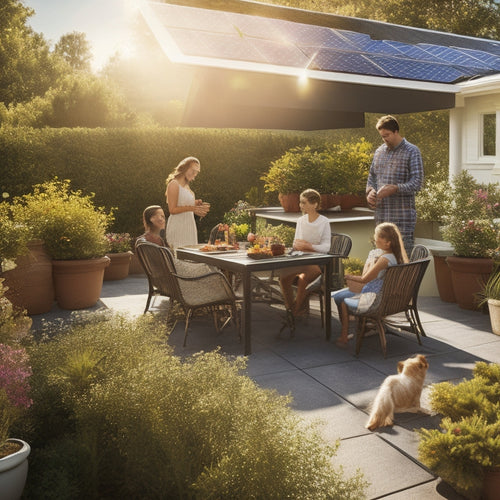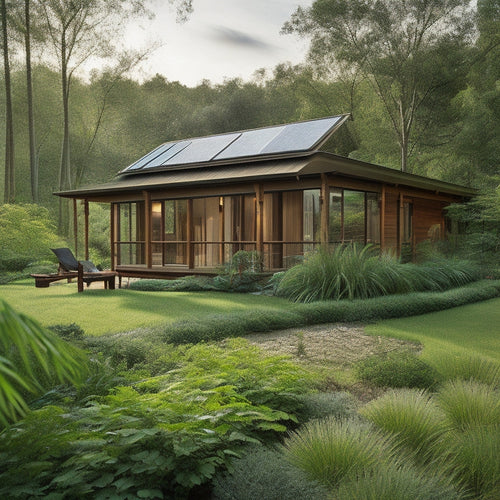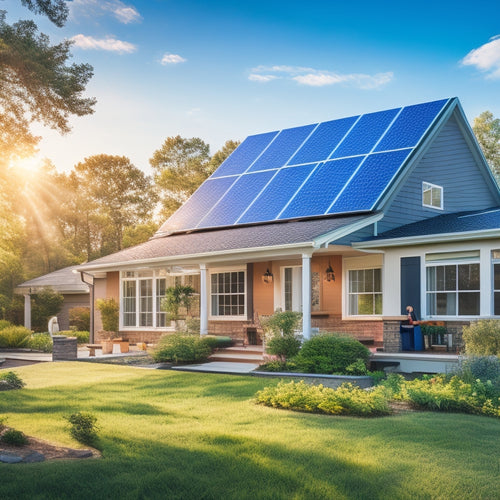
5 Most Efficient Sun Panels for Electricity Production
Share
You currently have access to solar panels with average efficiency ratings of 22.8%, markedly outperforming older models that typically ranged from 15% to 18% efficiency. Top manufacturers consistently exceed efficiency ratings of 20%, with high-performance solar cells featuring advanced manufacturing processes, multi-junction designs, and PERC technology to increase energy output. To maximize energy production, proper panel alignment is essential, allowing high-performance panels to convert up to 22% of sunlight into electricity. Now, you're likely wondering what specific panels offer the best balance of efficiency and cost - and that's exactly what you're about to find out.
Key Takeaways
- Today's most efficient solar panels achieve an average efficiency rating of 22.8%, driven by innovations in photovoltaic cell technology.
- Top manufacturers consistently exceed efficiency ratings of 20%, with high-performance panels converting up to 22% of sunlight into electricity.
- Monocrystalline cells with uniform crystal structure offer higher efficiency, while bifacial cells absorb light from both sides to boost energy yield.
- High-performance solar cells feature advanced manufacturing processes, including multi-junction designs and PERC technology, to increase energy output.
- Proper panel alignment, orientation, and tracking systems are critical for maximizing energy output and minimizing losses due to misalignments.
Top Efficiency Ratings Today
Currently, the most efficient solar panels on the market boast an impressive average efficiency rating of around 22.8%. You're likely wondering what makes these solar panels so efficient. The answer lies in recent solar panel innovations that have pushed the boundaries of what's possible.
These top-rated solar panels have surpassed previous efficiency benchmarks, thanks to advancements in photovoltaic cell technology and optimized panel design. As a result, they can convert a higher percentage of sunlight into usable electricity, making them more effective at generating power.
When exploring the market for high-efficiency solar panels, you'll notice that top manufacturers are consistently achieving efficiency ratings above 20%. This is a significant improvement over older solar panel models, which typically had efficiency ratings ranging from 15% to 18%.
High-Performance Solar Cells
As you investigate deeper into the world of high-efficiency solar panels, it becomes apparent that the key to their exceptional performance lies in the advanced technology of high-performance solar cells.
These cells boast higher power conversion efficiency rates, translating to more electricity generated per unit area. You'll find that high-performance solar cells are built using advanced manufacturing processes, such as multi-junction designs and passivated emitter and rear cell (PERC) technology.
These processes enable the cells to utilize energy from a wider range of sunlight, resulting in increased energy output.
When it comes to solar cell types, you'll typically find high-performance cells categorized as monocrystalline or bifacial.
Monocrystalline cells offer higher efficiencies due to their uniform crystal structure, whereas bifacial cells can absorb light from both the front and rear sides, increasing energy yield.
The precise engineering and state-of-the-art materials used in these cells enable them to operate at higher temperatures, further enhancing their performance.
Energy Output per Hour
When evaluating high-performance solar panels, you frequently find that their exceptional energy output is measured regarding energy output per hour. This metric is vital because it directly impacts the amount of electricity you can generate. A higher energy output per hour means more power for your home or business.
To maximize energy output, panel alignment is important. Proper alignment guarantees that the panels receive the ideal amount of sunlight, allowing for efficient energy conversion. Even slight misalignments can result in significant energy losses. As such, it's important to carefully consider the panel's orientation, tilt, and tracking system to guarantee maximum energy output.
In terms of energy conversion, high-performance solar panels boast impressive efficiencies. They can convert up to 22% of the sun's energy into usable electricity, making them highly effective.
Cost-Effective Panel Options
High-efficiency solar panels are often associated with premium pricing, but that doesn't mean you can't find cost-effective options that still deliver impressive energy output. You can opt for affordable models that provide a balance between performance and price. These panels may not boast the highest efficiencies, but they'll still generate significant electricity while saving you money.
When searching for cost-effective options, consider panels with efficiencies ranging from 18% to 20%. These models are often priced lower than their high-efficiency counterparts but still provide a substantial amount of power. You can also investigate panels with poly-crystalline or mono-crystalline cells, which tend to be more affordable than premium models.
Additionally, look for installation savings to further reduce your upfront costs. Many solar panel manufacturers offer discounts for bulk purchases or bundle deals that include installation services.
You can also consider working with local installers who may offer competitive pricing for their services. By combining affordable panels with installation savings, you can create a cost-effective solar panel system that meets your energy needs without breaking the bank.
Future of Solar Technology
Take a step into the future of solar technology, where innovations are rapidly unfolding to change the way you employ the sun's energy.
You'll find yourself at the forefront of a revolution, where solar innovations are being developed to maximize energy output and minimize environmental impact. One of the most significant advancements is in renewable integration, enabling seamless synchronization with traditional power grids. This means you'll be able to exploit the full potential of solar energy, without compromising on efficiency or reliability.
As you explore deeper, you'll uncover state-of-the-art technologies like bifacial panels, which can generate electricity from both sides, and perovskite cells, boasting higher power conversion efficiency.
These breakthroughs are set to reshape the solar arena, making it more accessible and affordable for widespread adoption. With the future of solar technology unfolding at an unparalleled pace, you can expect to see significant reductions in carbon emissions and a substantial shift towards a cleaner, more sustainable energy mix.
Get ready to tap into the limitless potential of solar energy and experience the thrill of powering your world with clean, renewable energy.
Frequently Asked Questions
Can I Install Solar Panels on a Rented Property?
You can install solar panels on a rented property, but you'll need permission from your landlord and a solid tenant agreement in place, considering solar leasing options to guarantee a mutually beneficial arrangement.
How Do I Clean and Maintain My Solar Panels?
While utilizing the sun's energy, you're also collecting dirt and debris; now, prioritize solar panel cleaning and maintenance tips to optimize performance, using soft brushes, distilled water, and avoiding harsh chemicals to maximize your electricity output.
Are Solar Panels Suitable for Homes With Low Roof Space?
You're wondering if solar panels are suitable for homes with low roof space. They can be, if you optimize your roof space by choosing compact solar panel types, like bifacial or thin-film panels, designed for maximum energy output in limited areas.
Can I Store Excess Energy Generated by Solar Panels?
You can store excess energy generated by solar panels using energy storage solutions like batteries, which allow you to capture and employ the power when needed, and investigate various battery options, such as lithium-ion or lead-acid, to suit your specific needs.
Do Solar Panels Work Efficiently in Cold or Cloudy Weather?
Crisp cold mornings and cloudy days don't cripple your solar panel efficiency. You'll find that modern panels still perform proficiently in cold weather, with some models boasting impressive efficiencies even in low-light conditions, ensuring you capture every available watt.
Conclusion
As you utilize the power of the sun, you're not just generating electricity - you're illuminating a brighter future. With the most efficient solar panels, you're bridging the gap between innovation and sustainability. Embracing state-of-the-art technology, you're changing your carbon footprint into a gentle whisper on the planet. Soak up the benefits of high-performance solar cells and bask in the glow of a cleaner, greener tomorrow.
Related Posts
-

Long-Term Cost Savings With Solar Panels
Investing in solar panels offers substantial long-term savings on energy costs. You'll benefit from federal tax credi...
-

Affordable Sustainable Building Materials for Homes
You can build an eco-friendly home on a budget by choosing affordable sustainable materials. Consider using reclaimed...
-

Solar Energy Grants and Incentives for Homeowners
Maneuvering solar energy grants and incentives is essential for reducing your installation costs. You can benefit fro...


